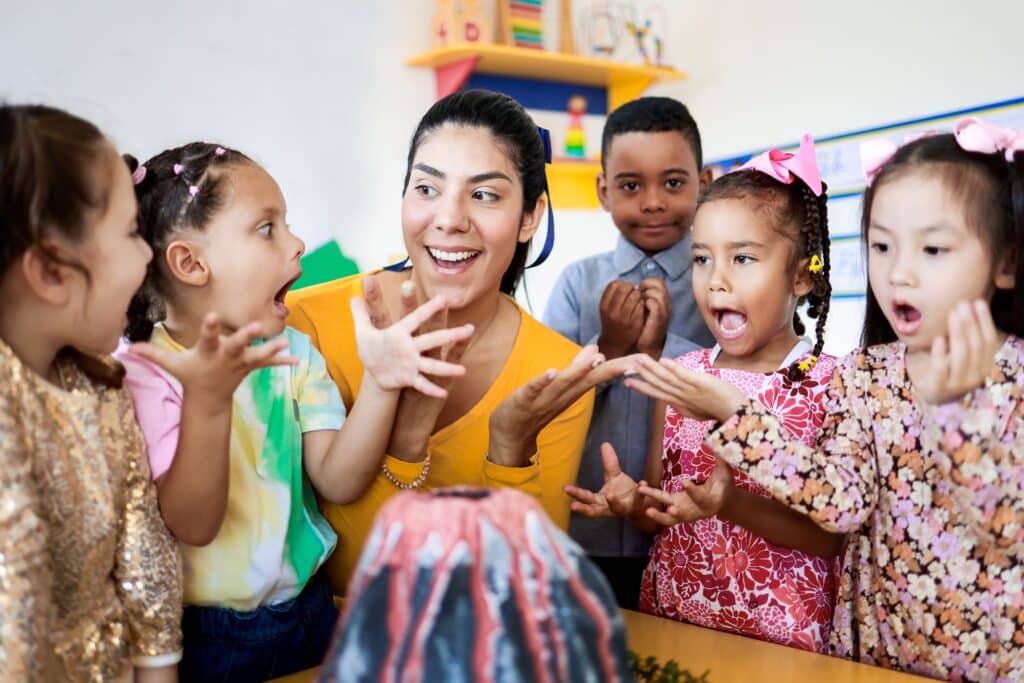The start of a new school year is an exciting time. It’s an opportunity to build connections and create a warm, welcoming environment where every student can thrive. While preschool can be a fun new adventure for little ones, it can also be challenging as young children learn to adjust to their new routines. To help make your journey smoother, here are some tips for preschool teachers to make your life easier and set your students up for success.
Set Up an Inviting Learning Space
Many preschoolers are used to the safe and familiar environment of their homes. So, when they step into the classroom for the very first time, you want to try and replicate that sense of security to help students feel safe, loved, and excited to learn. When setting up your space consider comfortable seating and natural light. Create various zones in the classroom like a reading nook, play area, dress-up corner, and a space for arts and crafts.
Ensure everything is placed at the children’s eye level, and label items with both words and pictures, as many young children are still developing their reading skills. These thoughtful touches will not only help children feel safe and comforted in their new environment but will also help them gain confidence and independence as they learn to navigate their way through preschool.
Establish Rules and Routines Early
Young children thrive on routine and knowing what to expect each day. Have a predictable routine that students must follow from the moment they walk into the classroom they leave for home. Map out your daily schedule and post it in the classroom. Use visual aids, like a picture schedule, so the children can see what comes next. Each morning, go over your schedule so students know what to expect throughout the day. Be sure to include time for play, snacks, learning activities, and rest time.
It’s also important to be flexible because, as you know, things happen in preschool, and it’s important for students to understand that sometimes you have to just go with the flow. Help students understand the importance of adaptability by discussing that sometimes plans change and it’s okay to go with the flow. This way, they’ll be better equipped to handle the changes calmly when things don’t go as expected.
Remember, preschoolers are new to routines, so be patient, with consistency and repetition, they will get the hang of it.
Incorporate Play
Play is the heart of preschool. It’s how students develop their social, emotional, and physical skills. Through play, children learn to cooperate with others, express their creativity, and develop their critical thinking skills. Whether they are building with blocks, pretending to be a cashier at a grocery store, or playing on the playground, they are developing skills that help them better understand the world around them. By incorporating play into your classroom, you are setting the stage for meaningful learning experiences. Here are a few ideas on how to integrate play-based learning into your classroom.
Pretend Play
Setting up a pretend play area in your classroom, like a kitchen, grocery store, or doctor’s office, gives children the opportunity to role-play and act out real-life situations.
Sensory Play
Sensory play involves activities that stimulate a child’s senses. This can include playing with sand, water, playdough, or sensory bins filled with various materials like rice, beans, or fabric.
Physical Play
Incorporate both indoor and outdoor physical play. Activities like running, jumping, climbing, and dancing help children burn off energy and improve their coordination, balance, and strength.
Constructive Play
Constructive play involves building and creating. Whether it’s with blocks, Legos, or other materials, this type of play encourages problem-solving, spatial awareness, and using fine motor skills.
Social Play
Social play occurs when children interact with their peers, engaging in group games or collaborative activities. This type of play helps children develop important social skills like sharing, taking turns, communicating, and working together toward a common goal.
Prioritize Social-Emotional Growth
Preschool is the perfect time to teach children how to express their feelings, share with others, and work together as a team. Model behaviors that you want students to emulate such as using kind words, practicing patience, sharing with others, and kindly expressing their feelings. Here are a few ways you can help preschoolers understand and develop these important social-emotional skills.
Use a Feelings Chart
Help children recognize and label their emotions by creating a chart with different facial expressions. Have children place their name next to the emotion that best describes how they feel. This encourages emotional awareness.
Create a Kindness Tree
Set up a tree on the bulletin board and each time you see a child do something kind, write it on a paper leaf and place it on the tree. This reinforces the concept of kindness.
Have a Sharing Circle
Have children sit in a circle and share something about themselves. This activity builds listening skills and empathy.
Create a Calm Down Corner
Set up a quiet place in the classroom where children can go to help manage their emotions. This teaches self-regulation.
Build Relationships with Students and Families
Build a strong bond with your students and their families. Start by getting to know each student one-on-one. Every day for one week, take three minutes to talk and get to know each student. By the end of the week, you will have created a bond, and students will feel valued.
It’s equally important to build relationships with families. Regular communication will help families feel like they are in the loop and reassure them that their child is in good hands. Be approachable and keep the lines of communication open to ensure that parents feel comfortable reaching out with any questions or concerns. When parents know, they can talk to you, it builds trust and strengthens the partnership.
Being a preschool teacher can be a lot of work, but it can also be a lot of fun. By creating a warm environment, establishing rules and routines early, incorporating indoor and outdoor play, fostering social and emotional growth, and taking the time to get to know your students and their families, you are setting the stage for a successful school year.
Educators never stop learning; check out our available graduate degree programs to hone your skills and promote lifelong learning and academic excellence.




